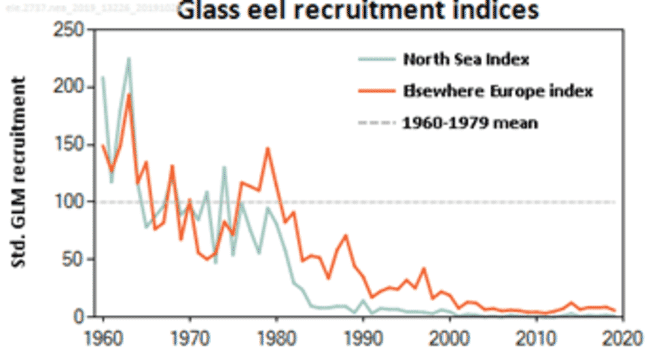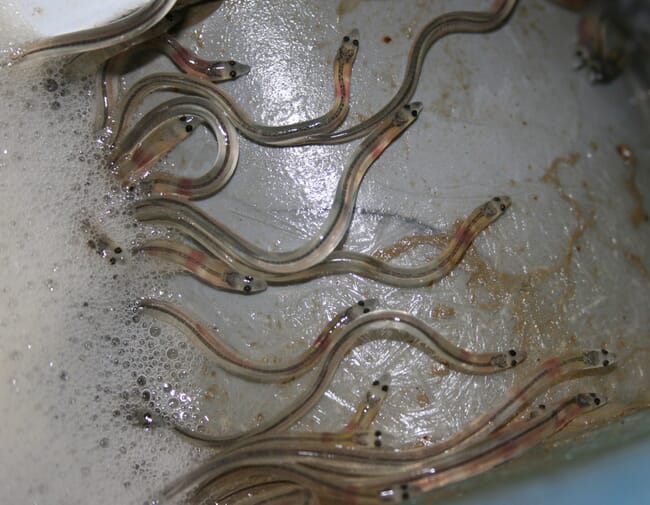The ICES Advice on Fishing opportunities, catch, and effort for European eel, written by the International Council for the Exploration of the Sea (ICES), reveals that the recruitment (the number entering European waters) of glass eels has stopped decreasing, disrupting a trend that began in 1980.

© ICES
Statistical analyses of time-series from 1980–2019 show that there was a change in the trend of glass eel recruitment indices in 2011; the recruitment has stopped decreasing and has been increasing in the period 2011–2019 with a rate statistically significantly different from zero. The highest point during the period from 2011–2019 was in 2014. For juvenile glass eels, the last five-year mean was an increase of 8.7 percent.
Andrew Kerr, chairman of the Sustainable Eel Group (SEG), commented: “SEG strongly welcomes the encouraging statement from ICES that the recruitment of European eel is now on the rise. We believe that this really positive news is thanks to the Eel Regulation and the combined efforts of EU member states. This is proof that international collaboration, however difficult, can work and that for an extraordinary species like the European eel is essential. Countries must now redouble their efforts and fully implement their national eel management plans since eel recovery is going to take many more decades. We hope that the combination of scientists, conservationists and commercial peoples all working together will be an inspiration to others.”
The European eel begins its life in the Sargasso Sea, near Bermuda. The larvae travel 6,000 km via Atlantic currents to the European coastline where they become glass eels. The glass eels migrate up rivers to become elvers and then yellow eels. Once they begin their migration back downstream into the sea, they turn into silver eels. No one has yet witnessed the European eel breeding in the wild, but it is thought to take place in the Sargasso Sea.
The number of eels reaching Europe dramatically declined between 1980 to 2011 because of a combination of overfishing, pollution and human infrastructure (such as dams and weirs) that block their natural migration. Since 2010, the species has been classified as “critically endangered” by the IUCN and has been listed in Appendix II of the Convention on International Trade in Endangered Species of Wild Fauna and Flora (CITES).

The illegal trafficking of European eels has also been undermining the species’ recovery, which has led enforcement agencies to prioritise countering eel trafficking.
Earlier this week, the EU’s law enforcement agency, EUROPOL, revealed that 5,789 kilograms of smuggled glass eels have been seized in Europe and 154 people arrested during the most recent fishing season (2018-2019) as a result of Operation Lake and Operation Fame. With an estimated value of €2,000 per kilogram, those smuggled eels were worth over €11.5 million. The operations brought together 10 European countries to coordinate efforts to hamper the illegal trade of European eel.
Commenting on an update on the illegal European eel trade in June, Jose Antonio Alfaro Moreno, operations specialist at EUROPOL said: “All the arrests mentioned are in Europe with the majority from Spain, France and Portugal. The main actions have been taken from SEPRONA, they have led the way in Europe along with the Portuguese and French authorities. Glass eels are trafficked out of the EU, put into eel farms in Asia and then sent back to the US, Canada and the EU. The development of this technology being used in monitoring the DNA of the eel has allowed us to prove that the European eel is coming from Asia. We have also collaborated with the EU Enforcement Group and the EU Food Fraud Network. The people arrested in Europe are poachers, mules and members from other criminal networks. We have focused not just looking at trafficking glass eels as a single issue, but the wider criminal networks. Year after year, more countries are joining our actions. For example, this year we are carrying out more work in Croatia, Czech Republic, Germany, Switzerland and Macedonia.”
The full report can be accessed here.


